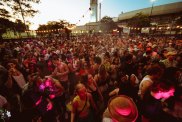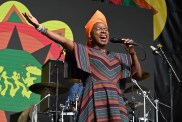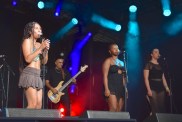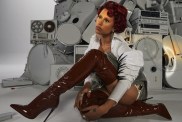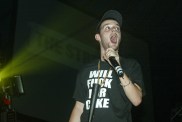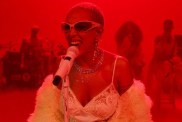“Flesh” (2011) by Ears
Galleries – who needs them? One enterprising crew of local artists led by Chris Lego and Daniel O’Toole have decided to stage their own art market in the backstreets of Newtown. It’s called the Artcore Guerilla Art Fair. It’s happening on September 15 and it’s designed to give artists a free, public space from which to spruik their wares. More than that, it’s a mini festival and celebration of the vibrant street culture that inhabits Sydney’s Inner West.
Music Feeds spoke with street artist Daniel O’Toole (aka Ears) about the Artcore, which is part of Sydney Fringe Festival and Festival of Free Spaces.
Music Feeds: Artcore seems like a great way for artists to bypass the middlemen – galleries that take hefty sales commissions. Is this one of the aims of Artcore Guerilla Fair? What other practical ways do you see for emerging Sydney artists to make a living out of their work?
Daniel O’Toole: I suppose so, although the work still has to be good or people on the street won’t stop and buy it. I also find people don’t want to spend much on an artwork they bought ofF a dude sitting on a milkcrate, even if it’s amazing and they love it. I generally do small works so I can move them quicker and I don’t have to drop my prices. It’s nice to set up your wares on the street with other artists because you get to hang out together and share ideas etc. I like the community aspect and sharing work on ground level rather than the more typical and less accessible gallery context.
MF: Do you have a day job? When did you realise you could make money out of your art-making practice?
DO: Making art is my bread and butter. I first realised I could make a living off my painting when I started giving away cardboard paintings on King St in 2007 and the response was overwhelming, I stopped cafe work that year and focused on my studio practice.
MF: Give us a snapshot of the Artcore Fair – who are your top three artists participating in the event for us to keep an eye out for?
DO: Well, the fair was organised by Chris Lego, who is a well known local arts activist involved with many creative festivals and projects, including Reclaim the Lanes. Birdhat, and Thorby (Skulk) would be my favourite artists to hang out with on the street, and we have often done a cheeky Sunday busk as a trio.
MF: To what do you attribute the mini explosion in DIY arts culture in Sydney?
DO: I think people are just more switched on to the net for info these days, and not patient enough to use traditional channels of media.
MF: What do you see as the biggest issues confronting creative thinkers and makers in Sydney at the moment? There’s a lot of discussion about the increasing expense of studio spaces, rent and so on – are these things that affect you as someone who’s active in the Sydney art community?
DO: I’m a bit lucky with my studio setup. ‘Higher Ground Studios’ is a collective of street artists: Phibs, Birdhat, Numskull, Beastman, Max Berry to name a few … located in a warehouse in Annandale, and we have a cheap rent deal because the space is founded by Look Print CEO David Leach, who is a patron and art collector himself. But I agree, studio prices in Sydney are a bit high as a rule. I’ve heard about people paying $150 a week for their space and I just think I’d really struggle to manage that kind of cost. I’d probably move to Melbourne at this point if it wasn’t for my amazing studio with such great friends. We have an open studio day on the 28th if people are interested in a peek.
MF: As an artist who skipped out of art school, do you see a big gap between Sydney’s independent artist-run community and the traditional art institutions?
DO: Yep, definitely. I’m not advocating leaving art school though, there are lots of great things about going to art school. It’s just not going to be everything. At the school I went to, I feel there was an outdated view of the artist’s life in society, like it was a bit romantic and unrealistic. While I was studying in first year, I was already getting flown to Melbourne for mural gigs and working with corporate clients. This was not what they saw as the artist’s role and it was too commercial for the institution’s liking, yet survival as a modern artist isn’t all openings and champagne.
MF: There’s been criticism among some in the Sydney indie arts community that this community is taking on an overly commercial or PR cast, or that it’s more of a ‘scene’ than a ‘community’. Do you see a trend? Do you think it’s a problem?
DO: Interesting point. I’m not sure it’s unique to Sydney, to be honest. We are a generation of artists with the tools and facilities to promote our own work online, and manage our own websites. This is a big shift, and galleries have less to offer a modern artist who has developed their own following and is easily reachable via a quick Google search. I suppose the main thing to remember is: no matter how commercially minded you are, the work comes first. The people who have genuine integrity and devotion to their art-making practice will do better in the long run; the hype dwindles pretty quick if it’s not based on anything substantial.
In regards to an art ‘scene’ rather than a community, I’m not sure I know the difference. I know that the word ‘scene’ has more negative connotations, but I’m not sure why. The fundamental function of an art ‘scene’ would be to bring people together who are like minded. Sounds a lot like a community to me.
Artcore Guerilla Art Fair is on September 15. Though the full location is top secret, you can head to Newtown Neighbourhood Centre (across from the station) and follow the arrows down the rabbit hole. There’ll be DJs, a musical line-up programmed by the Chess Club, Free the Beats stock for sale and even a little listening station set up with headphones for you to try before you buy.
In true Guerilla style, the full line-up is yet to be announced, but check out the FB page for full details.

